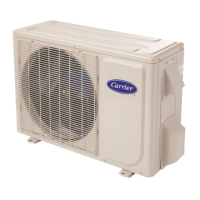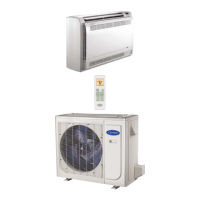
Do you have a question about the Carrier 38MAQB18-3 and is the answer not in the manual?
| Refrigerant | R-410A |
|---|---|
| Compressor Type | Inverter |
| Cooling Capacity | 18000 BTU/h |
| HSPF Rating | 10.0 |
| Voltage | 208-230V |
| Sound Level (dB) | 52 dB |
| Power Supply | 208-230V, 60Hz |
Details hazards, PPE, and signal words.
Warning about disconnecting power before servicing to prevent electrical shock.
Warning against using oxygen for leak testing or operating refrigerant compressors.
Table detailing voltage, MCA, MOCP, RLA, and FLA for different unit sizes.
Guidelines for sizing wires, using appropriate conductors, and connection methods.
Illustrates power and communication connections for 9K and 12K 115V units.
Shows connections for 9K to 30K units operating on 208/230V.
Illustrates the refrigerant flow for heat pump operation, including key components and sensors.
Procedure for achieving a deep vacuum using a pump and gauge for system evacuation.
Step-by-step guide for alternate triple evacuation method using nitrogen.
General steps, including checking diagnostic codes, wiring, and using a multimeter.
Table mapping operation/timer lamp flashes to specific error codes and statuses.
Table detailing error codes, LED status (Green/Red), and IU Display messages.
Troubleshooting steps for EEPROM parameter errors, including PCB replacement.
Troubleshooting flowchart for communication errors between indoor and outdoor units.
Guides on using a multimeter to test DC voltage and reactor resistance.
Troubleshooting for zero crossing detection errors related to PCB or connections.
Troubleshooting steps for issues with indoor fan speed control.
Procedures for checking DC fan motor voltages for 220-240V and 115V systems.
Troubleshooting for open/short circuits in temperature sensors.
Troubleshooting steps for refrigerant leakage detection errors.
Troubleshooting for overload current protection, checking power supply and blockages.
Troubleshooting for IPM malfunction and over-current protection issues.
Troubleshooting for over/under voltage protection, checking power supply and reactor.
Troubleshooting for compressor high-temperature protection, checking airflow and refrigerant.
Troubleshooting for inverter compressor drive errors, checking IPM and fan.












